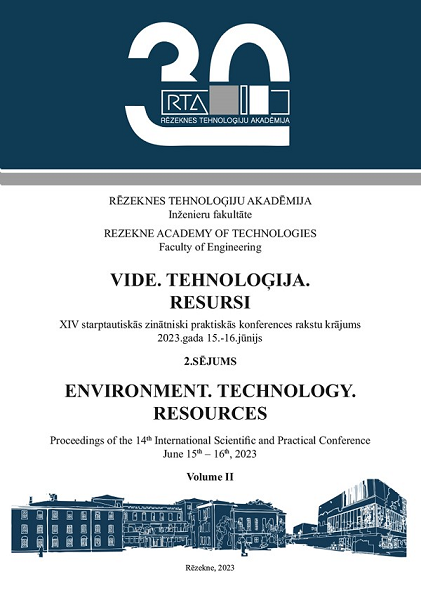AN REVIEW OF THE EFFECTIVE ENERGY CONSUMPTION WITHIN THE GREEN IT AND GREEN ENERGY STRATEGIES
DOI:
https://doi.org/10.17770/etr2023vol2.7295Keywords:
green IT, cloud computing, green energy, sustainabilityAbstract
The paper provides analysis on the current state of the art in the field of green technologies, including green information technologies, and methods aimed to achieve effective energy consumption goals. Recent advances in the field summarized in prospective publications, were analysed. Modern Green IT and Green Energy strategies, aimed to reduce power consumption, environmental influence and improve sustainability, which assume the use of Cloud Technologies, renewable energy sources, proper recycling and reuse of devices and resources, were singled out. Finally, recommendations for IT and industrial companies aimed helping to achieve green strategies’ goals, were formulated.
Downloads
References
N. Darnall, G. J. Jolley and R. Handfield, Environmental management systems and green supply chain management: Complements for sustainability? Business Strategy and the Environment, 17(1), 2008, pp. 30–45. doi:10.1002/bse.557
M. Uddin, S. Okai and T. Saba, Green ICT framework to reduce carbon footprints in universities. Advances in Energy Research, 5 (1), 2017, pp. 1–12, https://doi.org/10.12989/eri.2017.5.1.001
L. M. Hilty, B. Aebischer, Ict for sustainability: an emerging research field. In: L. M. Hilty, B. Aebischer (eds), ICT innovations for sustainability. Springer, Cham, 2015, pp. 3–36.
Z. Andreopoulou, E. Stiakakis and M. Vlachopoulou, Green ICT Applications towards the Achievement of Sustainable Development. In Z. Andreopoulou, V. Samathrakis, S. Louca and M. Vlachopoulou (Eds.), E-Innovation for Sustainable Development of Rural Resources During Global Economic Crisis, 2014, pp. 11–21, IGI Global. https://doi.org/10.4018/978-1-4666-4550-9.ch002
A. Jnr. Bokolo, A. M. Mazlina and R. Awanis, Green information technology adoption towards a sustainability policy agenda for government-based institutions: An administrative perspective, Journal of Science and Technology Policy Management, Vol. 10, N. 2, 2019, pp. 274-300
E. Oró, V. Depoorter, A. Garcia and J. Salom, Energy efficiency and renewable energy integration in data centres. Strategies and modelling review. Renew. Sustain. Energy Rev. vol. 42, 2015, pp. 429–445
P. Huang, B. Copertaro, X. Zhang, J. Shen, I. Löfgren, M. Rönnelid, J. Fahlen, D. Andersson and M. Svanfeldt, A review of data centers as prosumers in district energy systems: Renewable energy integration and waste heat reuse for district heating, Applied Energy, Vol. 258, 2020, 114109, ISSN 0306-2619 https://doi.org/10.1016/j.apenergy.2019.114109.
R. Kumar, S. K. Khatri and M. J. Diván, Optimization of power consumption in data centers using machine learning based approaches: a review, International Journal of Electrical and Computer Engineering, Vol. 12, Iss. 3, Jun 2022, pp. 3192-3203. DOI:10.11591/ijece.v12i3.pp3192-3203
Y. S. Patel, N. Mehrotra and S. Soner, "Green cloud computing: A review on Green IT areas for cloud computing environment," 2015 International Conference on Futuristic Trends on Computational Analysis and Knowledge Management (ABLAZE), Greater Noida, India, 2015, pp. 327-332, doi: 10.1109/ABLAZE.2015.7155006.
C. Reimsbach-Kounatze, C. Towards Green ICT Strategies: Assessing Policies and Programmes on ICT and the Environment, OECD Digital Economy Papers, 155, 2009, doi: http://dx.doi.org/10.1787/222431651031
J. Ahola, T. Ahlqvist, M. Ermes, J. Myllyoja and J. Savola, J. ICT for environmental sustainability: green ICT roadmap. VTT Research Notes, No 2532, 2010.
J. Servaes, Introduction to Green ICT. Telematics and Informatics, 29(4), 2012, pp. 335–336. doi: 10.1016/j.tele.2012.05.001
A. Al-Zamil and A. K. Jilani Saudagar, Drivers and Challenges of Applying Green Computing for Sustainable Agriculture: A Case Study, Sustainable Computing: Informatics and Systems. Sustainable Computing: Informatics and Systems, 2018. doi:https://doi.org/10.1016/j.suscom.2018.07.008
GeSI, SMART 2020: Enabling the low carbon economy in the information age. A report by The Climate Group on behalf of the Global eSustainability Initiative (GeSI), Global eSustainability Initiative, 2008.
GeSI, Smarter 2020: The Role of ICT in Driving a Sustainable Future. A Report by Boston Consulting Group on Behalf of GeSI. Global eSustainability Initiative (GeSI), 2012.
A.S.G. Andrae and A.T. Edler, On global electricity usage of communication technology: trends to 2030. Challenges, 6, 2015, pp. 117–157.
L. Belkhir and A. Elmeligi, Assessing ICT global emissions footprint: Trends to 2040 & recommendations. J. Clean. Prod., 177, 2018, pp. 448–463.
J. Malmodin and D. Lunden, The Energy and Carbon Footprint of the Global ICT and E&M Sectors 2010–2015. Sustainability, 10, 3027, 2018. doi: 10.3390/su10093027
L. D. Radu, Determinants of Green ICT adoption in organizations: A theoretical perspective. Sustainability, 8(8), 731, 2016. doi: 10.3390/su808073
Europe Sustainable Development Report 2022, Fig. 2.3. Available: https://eu-dashboards.sdgindex.org/chapters/part-2-priorities-to-restore-and-accelerate-sdg-progress-in-europe-and-globally [Accessed: Apr. 18, 2023]
Statistical review of world energy. – British Petroleum [Online]. Available: https://www.bp.com/content/dam/bp/business-sites/en/global/corporate/pdfs/energy-economics/statistical-review/bp-stats-review-2022-full-report.pdf [Accessed: Mar. 27, 2023]


